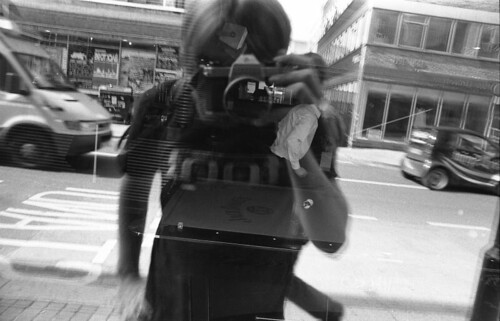




Cartier Bresson became famous for capturing amazing moments on 35mm film. In the 20's and 30's when he broke through with his first exhibitions, the 35mm camera was not well established as a tool. Delicately handling a small Leica he managed to juice the potential of photography as an art. Being trained as a painter, we can see how different his approach to photography is: while painting allows to produce any possible thing you might imagine given enough time, photography can -on the run- capture the most amazing, beautiful and ambiguous images. And still feel real.
You need
A small handheld camera with a quiet shutter. Having control of focus is a plus, as it allows you to select things and make jokes. Exposure control is not that important, after all, you shoot during the day. Lenses are really cheap as well: you either use a normal lens (50mm in a 35mm film camera) or a slightly wide angle (35mm in a 35mm film camera).
The eye of a painter in terms of composition. Is not only that you shoot quickly something that fills the frame with wonder, you also have to have the right backdrops and geometry for it.
The reflexes of a scorpion. You quickly bring your camera to your eye when you need it and shoot before being noticed. The sense of timing, the ability to freeze a moment on a print is what you're known for.
Somebody really good to produce your prints. After all, you're only worried about hunting the next image. That's all that matters.
Never to crop your images!
Always frame in terms of the horizon. After all, these might be strange fleeting images but they are available in reality.
Always use natural light. Black and white is a must, but we can drop the need for film by now.
Pros
Everybody loves your images. They are just stunning. They define what photography and photojournalism is about for years and years to come.
No matter where you are you can shoot. After all, you don't need to know anybody to see something interesting and snap it away.
It's damn cheap if you discount the travelling and the expenses on film (which are not that many rolls at the end of the day, just a few shots to set the scene and then the definitive, decisive moment shot).
Some rich women must love your ideas about art and politics.
Cons
You drive yourself mad in terms of what direction your photography should take. And you can't stand those magazines that you should be working for. Sometimes you give up photography for painting (and you're just average at it), other times, for the production of left wing documentaries.
Hiding your camera. It is small, but you are shy enough to have to hide it inside something else -yes, a cheap napkin will do-. In days of manflu this might lead to extensive cleaning of your equipment.
Getting bored waiting. Once you have the backdrops in place you have to stay lurking around for sometimes quite a long time. This definitively is not for everybody, and it can be a bit suspicious for people around (much more than walking down a street snapping at everything).
Overall
I must deeply recommend to all newcomers to shoot like Cartier-Bresson. It's unexpensive and can be done everywhere, and the pro's easily overcome the few things you have to worry about. All you need after all is a bit of eye and a camera that works. No trickery involved, so you don't really need to learn that much. Also, apart of producing beautiful images that your friends will love, it will skill your reflexes.

2 comments:
As you might know, the very first image in your post is one of the few pics that is always printed cropped, because of the bars to the left-hand edge of the picture. Actually, it is quite a drastic crop...
"Never to crop your images!"
Yes, Paul, but thats because its just black anyway (- he pushed the camera in between two planks in a fence.)
You need focus for "jokes"?
You havnt mentioned having a highly educated and trained artisitic sensibility, a genius gift for instant compisition, and the auster dedication of a Jesuit monk....
Post a Comment